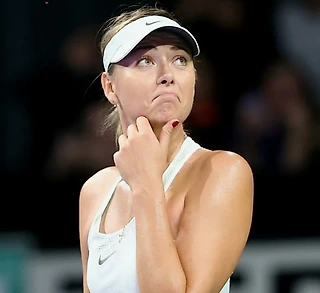CAS: Апелляция Марии - часть 30
В эту серию постов буду выставлять подробности апелляции Марии против решения Трибунала ИТФ.
Я предупреждал, что борьба за имя Марии не только не закончена, но только начинается после решения CAS. Несмотря на факт, что теперь отношение к Марии улучшилось, хейтеры Марии продолжают и будут продолжать борьбу против Марии. Им никак не нравится и решение CAS, и действия спонсоров Марии, и решение ООН, и признание Саймона, что WTA ожидает нашу Машу с нетерпением, им не нравится ничего, что в пользу Марии.
Если Вы думаете, что такие люди приняли решение CAS уменьшить срок наказания Марии, Вы глубоко ошибаетесь.
Хейтеры Марии постоянно пытаются уменьшить его значение и даже "доказать", что оно неправильно.
Внизу Вы можете прочитать статью, автор которой (Tom Rudkin) пытается сделать именно это – показать, насколько неправильным и ошибочным является решение CAS о Марии.
Он не болельщик, а специалист, и его статья опубликована не в какой-то "желтой" газете, а на уважаемом сайте.
Эта статья не газетное творение хейтера Марии, а попытка представить "научное" доказательство, насколько ошибочно CAS рассмотрел случай Марии.
Цель автора ясна. Он сам объяснил, что эта цель содержит и личный элемент. После решения Трибунала этот автор опубликовал другую статью, в которой "доказывал", что у Марии нет шансов победить в апелляции, вряд ли CAS найдет основания уменьшить срок 2-летнего бана и будет удивлен, если даже симпатизирующий Марии состав Экспертной Комиссии CAS присудит бан меньше 18 месяцев.
Теперь Вы знаете, этот автор оказался неправ. Точнее CAS доказал, что он неправ.
Понятно, почему сейчас этот автор пытается "доказать", CAS ошибочно решил апелляцию в пользу Марии - автор "спасает" и собственную шкуру специалиста.
Но важно отметить - все -таки эта статья написана специалистом, и ему надо отвечать специально таким же образом и таким же языком.
Я отвечу и ему лично, и выставлю посты для всех читателей блога, в которых проанализирую авторские замечания, мысли и утверждения.
Сейчас хочу сказать только одно - эта статья и этот автор показывают, насколько хорошо работали адвокаты Марии. Когда читаете аргументы автора, понимаете, как нелегко было адвокатам Марии убедить CAS принять такое решение.
A REVIEW OF THE CAS PANEL'S DECISION TO REDUCE SHARAPOVA’S DOPING BAN
Published 17 November 2016 | Authored by: Tom Rudkin
The author’s previous LawInSport article covered the decision of the first instance International Tennis Federation ("ITF") Tribunal in the case of five-time major winner, Maria Sharapova. In it, the author discussed Sharapova’s prospects on appeal of securing a reduction in the two-year ban that the Tribunal imposed on her.1 At the time, it was the author’s view that "CAS [the Court of Arbitration for Sport]'s findings on the facts will need to be very different if Sharapova is to obtain any reduction in her sanction" and that "it would be surprising if even a sympathetic CAS panel brought the sanction down to anything below 18 months".
CAS's eventual decision, the headline result of which was a reduction in sanction from two years to 15 months, therefore undeniably merits further analysis.2 In the aftermath of the decision, Sharapova's lawyer described it as a "stunning repudiation of the ITF and it exposes the ITF decision for what it is: pure fiction".3 Meanwhile, the ITF rejected criticism4 of the original ITF Tribunal, including any suggestion that it had been "not neutral", while also standing by the way in which it had publicised the inclusion of Meldonium (the substance for which Sharapova tested positive) on WADA's Prohibited List from January 20165.
Accordingly, this article examines:
The context of the CAS decision – a brief run through of the facts and the grounds of Sharapova’s appeal;
The CAS decision – the Panel’s findings in relation to Sharapova’s appeal for a reduction in her sentence on the grounds that she bore “No Significant Fault or Negligence” (see below) for her violation.
Comment – was it right for CAS to conclude that Sharapova’s choice of delegate (Mr Eisenbud) was reasonable and that she demonstrated "No Significant Fault or Negligence”; was it proportionate for CAS to reduce Sharapova’s ban by 9 months (from 24 to 15 months) in the circumstances?
THE CONTEXT OF THE CAS DECISION
At the outset, it is important to note that both the ITF Tribunal and CAS found that Sharapova had not committed an “intentional” anti-doping rule violation.6 The Tennis Anti-Doping Programme ("TADP") states at Article 10.2.3 that the term "intentional" refers to a player who has engaged in conduct that he/she knew constituted an anti-doping rule violation or knew there was a significant risk that this might be the case and "manifestly disregarded" that risk. This issue was concluded at first instance by the ITF's acceptance of Sharapova's assertion that she did not believe Mildronate (the name of the product in which Meldonium is contained) was a prohibited substance. This was reiterated by the CAS panel, which was at pains to make clear that "under no circumstances, therefore, can the Player be considered an “intentional doper". As such, the maximum sanction that could apply to her case was two years.7
The factual background to the matter is set out in more detail in the author’s first article.8 By way of reminder, Sharapova had provided two positive samples for Meldonium in January 2016, shortly after the substance had been added to the Prohibited List (being classified as a non-specified substance). These samples constituted an anti-doping rule violation under Article 2.1 of the TADP. The player's results from the Australian Open, during which the doping control test took place, were disqualified and, as noted above, the ITF Tribunal imposed a two-year sanction under Article 10.2 of the TADP.
In her appeal, Sharapova accepted that she bore some degree of fault and therefore did not plead a defence of "No Fault or Negligence" under Article 10.4 of the TADP. However, Sharapova sought to avail herself of the “No Significant Fault or Negligence” provision under Article 10.5.2 of the TADP and that, as a result, her ban should be reduced. That provision allows for a reduction up to 50% of the ban otherwise applicable. Moreover, Sharapova asked the Panel to exercise a further discretion to reduce the ban to an even shorter period, "consistent with the principle of proportionality".9
THE DECISION
CAS accepted jurisdiction to hear Sharapova's case pursuant to the appeal provisions at Article 12 of the TADP. Importantly, and as is well known under Article R57 of CAS's procedural rules, the appeal panel therefore had "full power to review the facts and the law", meaning that Sharapova's case could effectively be heard de novo.10 The panel alluded to and indicated its acceptance of the statement in WADA v Hardy & USADA11 that "the measure of the sanction imposed by a disciplinary body in the exercise of the discretion allowed by the relevant rules can be reviewed only when the sanction is evidently and grossly disproportionate to the offence" (emphasis added).12 However, the panel went on to say that, despite the high threshold this appears to imply, it in fact only means that a panel "would not easily tinker with a well-reasoned sanction". In Sharapova's case, the panel concluded that the ITF Tribunal had wrongly classified Sharapova's level of fault as significant. It is to be inferred that the panel therefore believed that the sanction could not be "well-reasoned".
At first instance the ITF Tribunal found that Sharapova could not establish No Significant Fault or Negligence ("NSF") in relation to her anti-doping rule violation13. In particular, it was held that Sharapova "[could] not prove that she exercised any degree of diligence, let alone utmost caution, to ensure that her ingestion of Mildronate did not constitute a contravention. To the contrary her concealment from the anti-doping authorities and her team of the fact that she was regularly using Mildronate in competition for performance enhancement was a very serious breach of her duty to comply with the rules. Her conduct was serious in terms of her moral fault and significant in its causative effect on the contravention".
This was based on a number of factual findings which can be summarised as follows:
In 2012 Sharapova elected to continue using Mildronate, with medical advice and despite her decision to stop following the overall regime of prescribed drugs that had been allocated to her by the Moscow physician, Dr Skalny.14
The only people who were aware of Sharapova's ongoing use of Mildronate after 2012 were her manager (Max Eisenbud of IMG), her father and (due to a single conversation) Dr Sergei Yasnitsky, the Russian Olympic team doctor.15
Sharapova did not disclose her use of Mildronate on any of the doping control forms she completed between 2014 and 2016.16
The approach Sharapova adopted for the purposes of checking her compliance with the TADP was considered casual and inept, especially in light of her profile as one of the game's leading players. This included the involvement of Mr Eisenbud in this process, and the ITF Tribunal noted his own evidence that "he professed not to have the basic understanding, which is required of every athlete subject to the WADA Code, of how the Prohibited List works."17 Importantly, the ITF Tribunal also highlighted the fact that Mildronate was among 3 substances that were treated differently from all the other medications and supplements "which were vetted by the player's medical team, not by [Mr Eisenbud], and recorded in emails and medical records".
However, CAS took a markedly different view, finding that the Player's fault was not significant.18 In particular, CAS noted that the bar should not be set too high for a finding of NSF and that it cannot be excluded simply because the athlete "left some 'stones unturned'".19 The panel also noted that the parties agreed that athletes were permitted to delegate elements of their anti-doping obligations and that, while "the objective fact of the third party's misdeed is imputed to the athlete… the sanction remains commensurate with the athlete's personal fault or negligence in his/her selection and oversight" of the delegate.20
In the panel's view, Sharapova's delegation of anti-doping responsibilities to Mr Eisenbud was reasonable. They noted that checking substances against the Prohibited List was not an activity for which specific anti-doping training was needed and felt that his experience as a sports agent for one of the world's biggest agencies made him suitably qualified for this role.21 Alongside this, the panel found that Sharapova justifiably had a reduced perception of risk, because
a. she had used Mildronate without any anti-doping issue for 10 years,
b. she did not seek treatment in 2005 for the purposes of enhancing performance; and
c. no specific warning had been issued by WADA, the ITF or the WTA about the change in status of Meldonium from a non-prohibited to prohibited substance.
The panel expressed the view that it was incumbent on anti-doping organisations to take reasonable steps to provide notice of significant changes to the Prohibited List, including the detailing of brand names for a substance (such as Mildronate for Meldonium). This contrasted with the ITF Tribunal's findings that the ITF had discharged its responsibility in this regard under Article 3.1.3 of the TADP and Article 4.1 of the WADA Code,22 and that any failure in this regard on the part of the ITF would have been, in any event, irrelevant to the determination of whether Ms Sharapova had discharged her duties.23
The CAS panel found that Sharapova had shown some degree of fault, because of the lack of instructions provided to Mr Eisenbud and the decision to rely on him "completely", along with the failure to establish any procedure to supervise or control Mr Eisenbud's actions. Sharapova did not put Mr Eisbenbud in contact with Dr Skalny when she left his care and also did not instruct Mr Eisenbud to consult the WADA, ITF or WTA website.24
Having considered the "totality of the circumstances" and having also noted Sharapova's failure to disclose her use of Mildronate on anti-doping control forms, the panel accepted her claim for NSF (noting that her failure was greater than the minimum degree of fault falling within NSF but less than Significant Fault).25 In their view, a sanction of 15 months was appropriate. The panel went on to reject Sharapova's claim under proportionality for an additional reduction in sanction, stating that "the WADC, from which the ITF ADP is derived and on which it is based, has been found repeatedly to be proportional in its approach to sanctions".
COMMENT
The CAS decision is problematic on a number of levels.
First, it is clear that, notwithstanding the finding that the delegation of responsibility to Mr Eisenbud was reasonable, the panel concluded that Sharapova had fallen short of her obligations under the TADP. As noted above, they referred to the level of reliance placed on Mr Eisenbud without instruction and the failure to disclose her use of Mildronate on her anti-doping control forms. Indeed, the ITF Tribunal raised serious questions as to plausibility of her justification for the latter failing26 and yet this is not referred to in the CAS decision. Either way, the CAS panel's own findings appear to identify key failings when it comes to the player's compliance with the TADP, and it remains difficult to understand why a reduction of nine months (from 24 to 15) was considered appropriate or reflective of those failings.
The panel also alluded to the framework for review of sanction in NSF cases as set out in Cilic v ITF27 and Lea v USADA28. Yet it is worth noting that both of those cases related to positive samples involving specified substances, where the possible range in sanction was 0-24 months. Meanwhile, in Sharapova's case the minimum sanction she could have received was 12 months, because Meldonium is a non-specified substance. Nonetheless, using the guidelines in the Cilic and Lea cases (which categorise the sanctions in terms of light fault (0-8 months), moderate fault (8-16 months) and considerable fault (16-24 months))29, it would appear that the panel concluded that Sharapova's fault was light, with the sanction falling into the lower third (i.e. 12 – 16 months) of what was possible in her case (namely a sanction of between 12 and 24 months).
Moreover, the reasonableness of the decision to delegate to Mr Eisenbud is also questionable. At the outset, this has to be placed alongside the principle of strict liability and the additional requirements of Article 1.12 of the TADP which are the "sole responsibility" of the player and include ensuring that anything they ingest does not give rise to an ADRV. This is set against Mr Eisenbud's own evidence before the ITF Tribunal which was that he had no training to understand the composition of the Prohibited List and had no basis understanding of how the list works. Readers will also be aware of the severe criticism made of Mr Eisenbud's account of the checks he undertook to ensure Sharapova's compliance with the TADP and, in particular, the reasons he gave for failing to check the Prohibited List properly in late 201530. By way of reminder, Mr Eisenbud had said that he usually checked the Prohibited List on a Caribbean holiday in November, but that the holiday had not happened in 2015 due to his split from his wife. There have to be serious questions as to whether Sharapova could simply rely on the delegation to Mr Eisenbud and not take more of the responsibility for failing to ensure that the checks were being carried out properly. The reduction in sanction by CAS arguably does not encourage players to take that responsibility.
The panel also acknowledged the requirement to consider the totality of the circumstances. Yet, they failed to address in detail some of the criticisms made of Sharapova's conduct in the ITF Tribunal decision. In particular, the panel did not refer to some of the important factual evidence. This includes Sharapova's decision to continue using Mildronate after she stopped following the regime recommended by Dr Skalny, and in particular the fact that this decision was made without medical advice.31 Moreover, the ITF Tribunal had found on the evidence that Sharapova's continued use of Mildronate was only known to Mr Eisenbud, her father and (due to one conversation in 2015) the Russian Olympic team doctor.32 In the CAS decision, the panel stated that "she was in fact open about it to many in her entourage".33 This apparent change in stance was left unexplained (at least in the published decision).
In the circumstances, the CAS panel's decision appears to be a lenient one on the facts available and rows back from – or at least might give players the impression that it is rowing back from – the strict obligations and requirements placed on them by the anti-doping rules. The significant reduction in sanction does not appear to be based on materially different findings on the facts. Instead, in the view of this author, that it centres largely on the reasonableness of Sharapova's decision to delegate anti-doping responsibilities to Mr Eisenbud. The panel's conclusions on this point are open to criticism given Mr Eisenbud's own admissions about his lack of understanding of the Prohibited List.
It is clear in this case that no one was suggesting that Sharapova was a drugs cheat. Nonetheless, it is evident that Sharapova’s conduct fell well short of that required by the responsible athlete acting in total compliance with the WADA Code. This was recognised both by the ITF Tribunal and CAS. In finding that Sharapova’s fault was not significant and in reducing her sanction by nine months, the CAS panel, in the view of the author, may have set a precedent that a) sets the bar too low for athletes to meet the requirements of NSF and b) demonstrates an excessively lenient approach even where a NSF finding is justified. It is hoped that this decision does not inadvertently result in some players taking their anti-doping responsibilities and obligations less seriously than is required.
COPYRIGHT NOTICE
This work was written for and first published on LawInSport.com (unless otherwise stated) and the copyright is owned by LawInSport Ltd. Permission to make digital or hard copies of this work (or part, or abstracts, of it) for personal use, professional training and/orclassroom uses is granted free of charge provided that such copies are not made or distributed for profit or commercial advantage, and provided that all copies bear this notice and full citation on the first page (which should include the URL, company name (LawInSport), article title, author name, date of the publication and date of use) of any copies made.
ABOUT THE AUTHOR
TOM RUDKIN
Tom provides reputation management and contentious media advice to the full range of Farrer & Co's clients. He is a member of the firm's Sports Group and, as well as assisting sports clients on reputational, media and other sensitive issues, he advises on sports-based disputes, rules and regulations and commercial contracts. Tom's work spans from advising National Governing Bodies to high profile sportsmen and women. He has also spent time in-house on secondment at the Lawn Tennis Association.
(продолжение следует)
Предыдущие посты на эту тему Вы можете найти здесь:
Книга «Наша Маша» - Глава «Трибунал: Защита Марии»
https://www.sports.ru/tennis/blogs/922491.html
>
>










Через несколько недели увидим и спортивную форму Марии, и я думаю она будет ОК.
Жизнь как парикмахер: ты ей говоришь, чего ты тебе хотелось, а она делает то, что хочет сама.
Откуда посыл, что ее ненавидят соперницы, науськивать всем стадом и тд? Есть принципиальные соперницы, которые не любят Маше проигрывать и высказались: Цибулкова, Младенович, Стосур, есть Серена (вот только холивара не надо), которая слова плохого не сказала, есть Халеп, которая высказалась, что подругой не были, и начинать нечего, по большому счету, кто там ее так ненавидит? Уверен, что большинство хочет сыграть с нею, это для них огромная мотивация, и не потому что для них она раздражитель, а потому что победитель 5 турниров БШ и показатель твоей собственной формы.
Я не согласен с Денни, что мнение людей можно изменить, в этом у нас разный взгляд, мнение уже сформировано и давно СМИ, с этим бороться словно против ветра ..., но можно минимизировать потери и Маша это делает безупречно, она не исчезает из поля зрения, дает инфо поводы, но без негатива, показывает себя а соцсетях и как спортсмена, и как простую девушку (респект ее pr или ей самой за фото с бургером к примеру), акцентируя внимание на главном - возвращении, перепостами своих поклонников. Баланс идеальный. Молодчуля, имхо:)
Суть не в этом. Вы большой молодец, в одиночку боретесь с людьми, которые сидят в офисах на зарплате, и штампуют разные гадости про Марию. Но вы, наверняка, понимаете, что победить их будет невозможно. Какие бы аргументы и доводы им бы не приводили. Им вообще плевать на голос разума и логики (вполне возможно, что некоторые из них даже и не ненавидят Марию), просто они так зарабатывают деньги и будут продолжать это делать. Поэтому я и сказал, что всё решится на корте и только там. Только там Мария или победит, или не сразу.
А что касается "дискотечной тусовки", вы же не думаете, что Мартина Хингис или Ришар Гаске - наркоманы иди кокаиновые доперы. Они просто зашли "не в тот бар" и "не с той компанией". И вы, не хуже меня знаете, что в среде IMG-моделей, кокаин вещь более чем обычная. А дальше я позволю себе процитировать Конфуция: "Умный человек легко найдёт выход из любого сложного положения, даже из такого, в которое очень умный, никогда не попадёт".
Жаль, если вы увидели в моих словах намерение лишить Машу личной жизни, просто ни мне, ни вам, ни тем, кто вокруг Маши на этих фото, никогда не придётся сдавать анализы на допинг тесты WADA, и максимум, чем мы с вами можем рисковать - это правами на управление машиной, но не более того. А цена вопроса для Марии гораздо более высока. И те люди которые хотели повести её на трибунал никуда не исчезли, и они не успокоятся, и своих попыток не оставят.
_____________________________________________________________________________________________________
А что вас так раздражает? А если просто повеселиться и отдохнуть с друзьями, почему нет?
Вы правы. Спасибо что еще раз напоминаете об этом, так как это преимущество может оказаться очень важным в мае 2017 года.